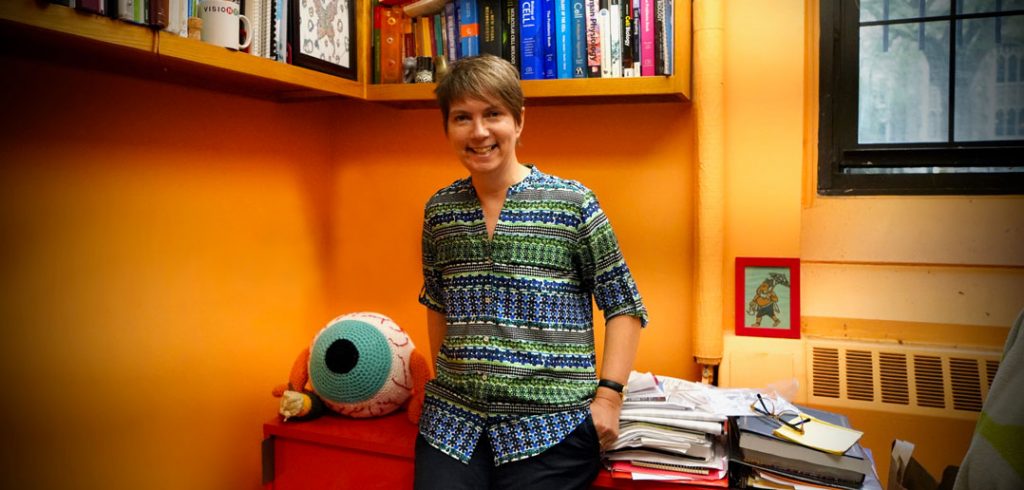Since she became the first Kim B. and Stephen E. Bepler Chair in Biology last fall, she has used her new position to pursue new or previously underfunded research projects and dedicate more time toward her student mentees in her Larkin Hall retina cell biology laboratory. And soon, she’ll be showcasing her research to scientists in Japan.
Your lab specializes in retinal neurobiology. What does that mean?
We study the long-term maintenance of the retina, the neural tissue in our eyes that allows us to see. How does our retina manage to function for life? What are the cellular and tissue mechanisms that are responsible for life-long visual function?
What made you interested in studying the human eye?
The eye is a particularly beautifully organized organ. Also, our visual sense is enormously important to most of us. If you ask people what they are afraid of when it comes to their health, they say cancer and blindness. To this day, even in developed countries, the risk of having visual impairment with age is very high. Diseases are not necessarily hereditary, and they affect a very large percentage of the elderly—age-related macular degeneration is diagnosed in about 25 percent of the U.S. population over 75. So there is a medical need.
As a scientist, I also like the eye because unlike the brain, it’s easy to access. You can look at part of the central nervous system by shining light into the eye. You can’t use eye drops on brains. The accessibility of the eye, from an experimental point of view, is a huge advantage. There’s no other part of our central nervous system—brain, neural retina, spinal cord—that you can manipulate in real time and take a look at.
What brought you to Fordham?
When I came to Fordham in the fall of 2008, I was already an established principal investigator. I had been Assistant and Associate Professor at Weill Cornell Medical College for several years. The move to Fordham was really motivated by the opportunity to integrate research and science education at the immersion level, where students come into the lab, participate, and understand what professional lab research is really about. That is what makes my Fordham lab different, not only from my previous lab at the medical school but also from many other labs of my colleagues and competitors around the world.
How has the Bepler endowed chair changed your life as a scientist and professor?
The Bepler endowment allows me to be more present in the lab and work on experiments directly on a daily basis and often with my mentees. For instance, I used to ask my students to email me their research results at night. Now I can actually be there in real time.
I also have the opportunity to participate more often in international conferences. For instance, this fall, I’m invited to participate in a workshop called “The retina—Mechanism of photoreceptor degeneration and regeneration, and roles of immune system” hosted by the Okinawa Institute of Science and Technology Graduate University in Japan. I will teach budding retina cell biologists and physicians about the work in my lab, possibly recruit new investigators and collaborators, and spread the word about Fordham as an institution with a vibrant Ph.D. program, where graduate students join labs like mine. The flexibility that I have, supported by the Bepler endowment, makes that a lot easier.
With funding from the endowment, I was also able to push an important project to completion. We found that by using biosensor eye drops alone—a non-toxic, gentle procedure—we can detect early-onset retinal degeneration in experimental models at a stage where rescue, and thus prevention of vision loss, may still be possible. Using these diagnostic eye drops, we can monitor blinding disease and maybe make decisions on therapy without having to do any kind of invasive testing.
At the moment, what’s the most exciting thing happening in your lab?
A second, new eye drop study. Unlike the first study, these aren’t diagnostic eye drops. This time, we’re actually providing therapy. We’re delaying blindness in an animal model that carries a mutation also found in human patients. The animal we are studying for this particular project is called the Royal College of Surgeons rat. It’s a very well characterized, classic animal model for retinitis pigmentosa, which is a hereditary form of blindness that is very frequent in the human population. The idea is that anything we give to the animal that is actually working will then be picked up by physicians and used to delay blindness in human patients.
What is the most rewarding part of working with young scientists?
The students, for the very first time in their lives, are realizing how it feels to perform an experiment to the best of their abilities and to obtain a result that nobody else in the whole world has ever seen before. To make scientific progress means discovery at a very fundamental level. And that is a thrill—the thrill of discovery in and of itself.
This interview has been edited and condensed for clarity.


